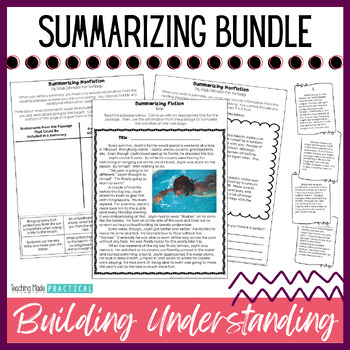Summarizing Activities & Worksheets Practice / Lessons - Reading Passages, More
- Zip

What educators are saying
Products in this Bundle (2)
Also included in
- Use this reading comprehension bundle with its scaffolded activities to help your students build a solid understanding of main idea and details, summarizing, and finding the theme. The resources break down these difficult skills into step by step chunks to give students a strong foundation. Best oPrice $16.00Original Price $25.00Save $9.00
Description
This summarizing bundle has everything you need to help your students be successful with this difficult skill! It combines 2 resources for summarizing practice - Summarizing Nonfiction and Summarizing Fiction. These no prep lessons and activities make creating an effective and engaging summarizing unit much easier on you.
Included in this Summarizing Bundle:
This resource contains nonfiction reading passages and activities to help students build a better understanding of what makes a good summary when summarizing informational text. The activities build on each other to help you scaffold and differentiate as necessary. Many summary examples are provided - examples of both good summaries and bad summaries. This helps make teaching summarizing to upper elementary students easier.
This resource focuses on helping students understand that:
1. Summaries should only include information from reading passage or book. Additional information should not be added to a summary.
2. Summaries should only include what the author of the passage thinks. You do not add your own opinion to a summary.
3. Summaries should only include the most important information. Students should only summarize key details.
4. Summaries should include enough information to tell the important ideas, but not too many unimportant details.
5. Summaries should be in your own words. A summary should not be copied word for word.
Each of these aspects of a summary are practiced in isolation with a reading passage and a cut and paste activity. Practicing each aspect of a summary in isolation helps make summarizing more understandable to all of your 3rd grade, 4th grade, or 5th grade students, including ELL students or special education students.
You can use these activities as summarizing lessons, or have students practice what they have already learned in a center. There are also activities that could be used as a summarizing assessment, or as a summarizing review.
This summarizing informational text resource does NOT primarily focus on having students practice writing their own summaries. Instead, it is laying the foundation so that students have a really thorough understanding of what makes a good summary. This resource has students spend a lot of time differentiating between "good" summaries and "bad" summaries so that students know what should included when they begin to write their own.
This resource contains fiction reading passages and activities to help students build a better understanding of what makes a good summary. The activities build on each other to help you scaffold and differentiate as necessary.
This resource includes 6 fiction texts / stories to help teach students how to summarize. Each text has both good summaries and bad summaries included as an example for students, as well as cut and paste activities. Each of the fiction texts focuses on one aspect of summarizing for students to practice.
This resource focuses on helping students understand that:
1. Summaries should only include information from reading passage or story. Additional information should not be added to a summary.
2. Summaries should only include what the author or character thinks. You do not add your own opinion to a summary.
3. Summaries should only include the most important information. You only include key details in summaries.
4. Fiction summaries should include the main problem and solution from the story.
5. Summaries should be in your own words. When summarizing fiction passages, the text should not be copied word for word.
This resource does NOT primarily focus on having students practice writing their own summaries. Instead, it is laying the foundation so that students have a really thorough understanding of what makes a good summary of fiction. This resource has students spend a lot of time differentiating between "good" summaries and "bad" summaries. These summarizing samples help so that students know what should be included when they begin to write their own.
This resource now includes a digital version for use with Google Classroom / Google Slides.
Check out the preview to see how this resource builds on different skills and to see everything included.
If your students are struggling with summarizing, they might need a more solid understanding of main idea. You might find my best selling Main Idea Resource useful.
You might also like:
Nonfiction Text Features: Posters, Centers, and No Prep Activities
Compare and Contrast: Nonfiction
Kalena Baker, Teaching Made Practical






